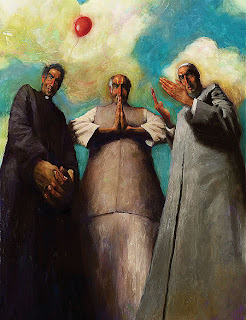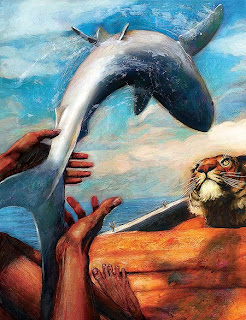 In May last year, the Flippers’ first book discussion was on the book Life of Pi by Yann Martel.
In May last year, the Flippers’ first book discussion was on the book Life of Pi by Yann Martel.
Before the discussion, I’d seen the book around but never felt the urge to pick it up. I rarely pick up books with spiritual/ inspirational themes because they trigger an involuntary gag reflex in me, so I was dreading reading this book.
Surprisingly, the gagging never came because I actually liked the book. Not in a love-it-to-bits sense, but I appreciated it, and was glad the book discussion required me to read it.
Life of Pi is the story of Piscine “Pi” Molitor Patel, a boy of multiple religions, who is a shipwreck survivor floating adrift in the ocean on a lifeboat with a circus tiger named Richard Parker.
I like the book because it questions perception, and because it reminds us that sometimes the journey is more important than the destination.
To my surprise, I also enjoyed the book’s humor. I really appreciate good humor in a book, and I did not expect this book to make me laugh, but it did, especially the part when Pi was practicing the three religions and the family runs into all three religious leaders and his multi-belief system is revealed; the Pi Patel Indo-Canadian, Trans-Pacific, Floating Circus; the encounter with the Frenchman (whom Pi mistook to be Richard Parker at first); and the interrogation scene at the end of the book.
But this review isn’t about the story of Life of Pi, it’s about a particular edition of the book: the deluxe illustrated edition, featuring the paintings of Croatian Tomislav Torjanac.
In 2005, an international competition was launched to find an illustrator for the novel. Thousands of entries were sent in from all over the world, and Torjanac was selected to illustrate the deluxe edition.
From Amazon Outtakes:
Here are some illustrations, from http://www.torjanac.com/lifeofpi.html and http://lifeofpi.co.uk (copyright Tomislav Torjanac)
I think it’s great, how Yann Martel and the publishers thought of involving readers this way. I can imagine the feeling, if for instance, JK Rowling did it for one of the Harry Potter books (or if a local publisher comes up with a Filipino translation and mounted a similar contest — hahaha, my fantasy), or if any of my other favorite books were up for illustration.
I would think it’s exciting and scary at the same time, to be given a chance to illustrate a a new edition of a book you’ve loved for a long time, with the knowledge that hundreds of people around the world have loved it too and are eagerly awaiting your illustrations.
I remember a discussion about illustrated novels posted at Flips Flipping Pages last year. Someone commented that a lot of bestsellers are getting illustrated, and he wasn’t quite sure if it was a marketing ploy, or if readers had such short attention spans that they needed to have books with pictures. b
Those reasons probably hold true, and I say, if it gets more people to read, so much the better.
But speaking as an illustrator, I see the illustrations as an extension of the reading experience, not mere accompaniments to the text. Illustrations translate one art form (literature) into another (visual art), much like a book made into a movie, and can convey a meaning beyond the text, as the illustrator adds his or her own nuances in interpreting the text.
And speaking as a big fan (and obsessive bargain-hunting collector) of illustrated novels, I say there is nothing wrong with enjoying an illustrated book; it doesn’t mean you lack imagination or need a visual aid. It’s about appreciating it for what it is – art!
***
My copy: hardbound US (Harcourt) with dustjacket, a birthday gift from Triccie
(Back story: I lent my brother my trade paperback, he took it to his dorm and it was devoured by termites — he now grovels if he wants to borrow a book)
My rating: Life of Pi Illustrated Edition 5/5 stars; Life of Pi trade paperback 3.5/5 stars






